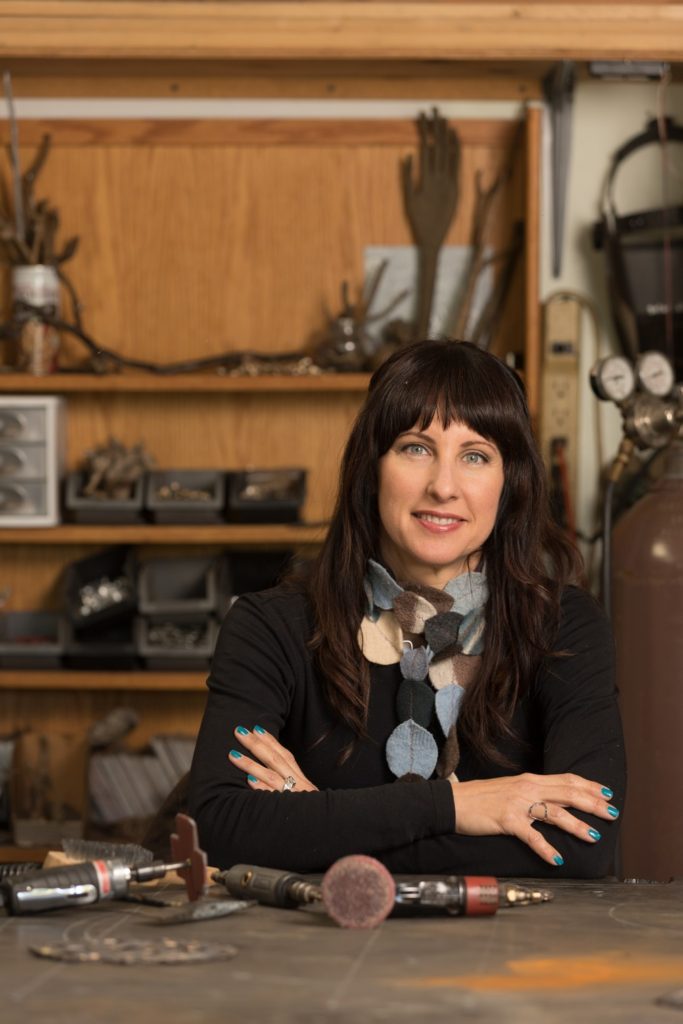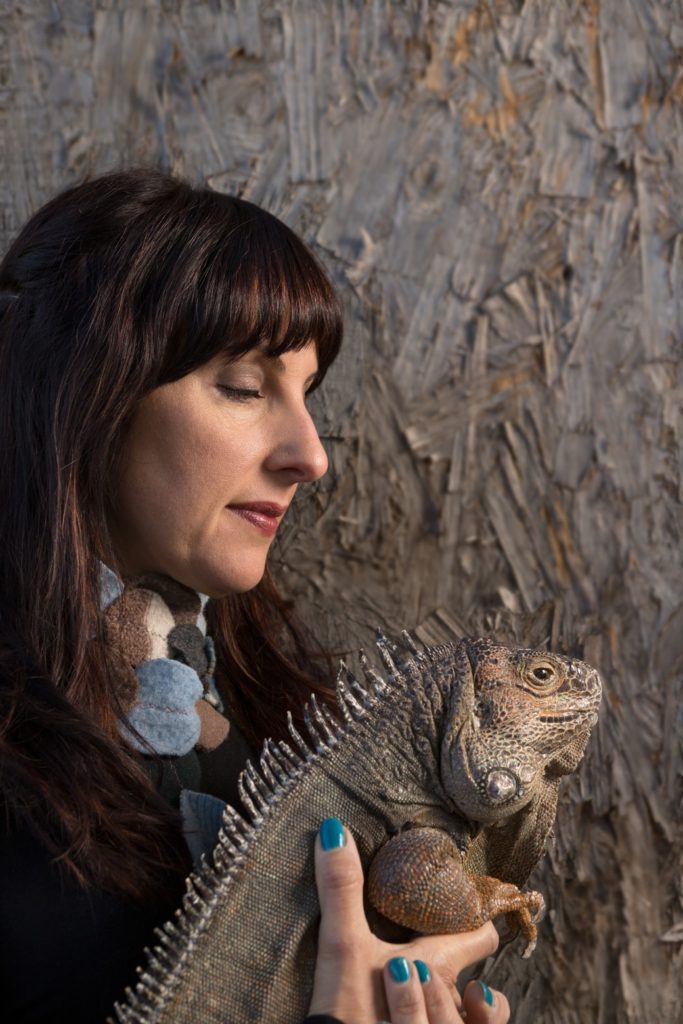Writer Amanda Christmann
Photography by Scott Baxter
[dropcap]W[/dropcap]arm, heavy air and the acrid smell of earth and fire have settled into the dust. Tables and racks scarred by creative sparks stand solidly on the concrete floor, and motley tin cans filled with odds and
In the middle of it all, a masked figure stands before a glowing crucible, its heat echoing in rumbles through the room. Embers escape from the glow of the vessel, flying like stars toward the heavens before their passion light fades and gravity drops them to the floor.
Wearing a heavy apron and thick gloves, the smith works a pair of smooth metal jaws, extracting a crucible of bronze lava from the heart of the furnace. The molten metal flows from the crucible, and thin, vine-like designs emerge from inside the mind beneath the mask.
What began as cold ingots becomes a beautiful artistic expression as the bronze begins to cool. Though its state is transformed, energy from the heat and passion that created it remains inside.
With an unconscious flourish, a gloved hand nudges the square mask upward, and an elf-like face framed by a fringe of bouncy bangs emerges.
A dark ponytail cascades over one shoulder and blue eyes shine as Jennyfer Stratman removes her gloves and smiles, content with her work.
A renowned metal sculptor, Stratman’s creativity and zest for life seem to abruptly contrast with the stark surfaces of her Phoenix workshop. Yet it is here where some of her best work has been born.
Just outside, surrounded by eight acres of open desert, she shares her shady space with four horses, a tribe of goats and an iguana named Cosmo. She dedicates about half of her time in this little oasis; the rest is spent on a life she’s built for herself in Australia.
It’s not a conventional life, but then again, Jennyfer Stratman was never destined to be ordinary. Raised in the Valley, Stratman has always marched to her own beautiful beat. It’s something she comes by honestly.
“My mother was a photographer and very creative. I think that part of her spirit will always be in me,” she says.
She made her first ceramic sculpture of a dinosaur when she was three, and she’s been expressing herself through art ever since.
For years, ceramics were her preferred medium, but over time, her figures began to change. They sprang roots that begged to dig deeper, and branches that reached toward the stars.
“By the time I was at ASU, my ceramic sculptures were becoming so tall and thin that they were often breaking under their own weight and gravity. My professor nudged me toward the foundry, and I never looked back.”
She is known for her work in cast bronze, steel, aluminum and pewter, but she occasionally mixes it up by adding touches of wood or ceramics.
“There is a sort of spiritual force in these earth-based materials that translates well with the conceptual side of my practice,” she explains. “The materials of the earth, in a way, dictate the form of something. They have their own personality. They do what they want sometimes.”
Stratman has the uncanny ability to create pieces that, at first glance, may appear simple, but that draw the viewer in with surprising, thought-provoking details. Human forms often show up in unexpected places, and flower-like blooms burst from the earth and skies, painted in brilliant International Klein Blue.
“For me, it’s an ethereal and other-worldly color,” she says of the brilliant hue. “It translates the cosmic ideas I have into my work. It’s an interesting color, and it elicits an almost emotional response.”
Her eyes smile beneath a pair of librarian-chic glasses, and she tucks her small hands into her jeans pockets, as if to hold them back from punctuating her sentences.
She adds, “Originally, my work was more sparse. Over time, it has developed a lot more life and complexity to it.”
As much as her expression has changed, her overall message has always been the same.
“Most of my work had an ethereal theme, even from quite a young age. A lot of it has ideas of the cycle of life or birth, transformation and renewal.
“While much of it is loaded with metaphor for my personal journey, we share many similar experiences. I think that’s why a lot of people can relate to what I do,” she adds.
To illustrate, she points to a round bronze sculpture she created. It’s a self-portrait of sorts, and its gorgeously complex roots, bright blue flowers and golden starbursts carry a theme common in much of her work.
A lone figure stands in the center, connected to both the earth and the sky.
“The figure suggests the interconnection that we have with nature and the cosmos. It represents the essence of humanity and the body while longing for connection with people,” she explains.
“The trees are a metaphor for growth and renewal. The cycles of trees are a metaphor for my life being uprooted from Arizona and transplanted to my second life in Australia.
“When I first moved and was trying to find my way in a new country, the simple tree roots I was making started to grow. As I get older, my work is blossoming with life and I’m finding myself connected with other people in more spiritual and emotional ways.
“There is often a duality in my work—being connected to my roots and also creating a second life in a new country. One of those two sides to myself is longing for my homeland and the other open to new experiences.”
It’s an autobiography of sorts for the part-time Melbourne, Australia resident.
“My husband is Australian. We met in 1995 when I took a semester off of college and backpacked through Europe. I ended up in a hostel in Edinburgh, where I met Brad.”
Together, they’ve built a two-faceted life, splitting their time between two very different worlds. Growing up in the Valley, Stratman was organically drawn to other artists and stepped into the gallery and public art scene quite naturally. Though it took time, through the years Stratman has nudged her way firmly into the Melbourne art scene, too.
She’s not just a hometown artist. Stratman has exhibited in 28 solo and over 100 group exhibitions throughout the world. From public art to private collections, her work can be found in the United States, Australia, Canada, Hong Kong, Singapore, Taiwan, Israel, England and throughout Europe.
In the Valley, Stratman’s work is on display at Grace Renee Gallery in Carefree.
“I love the range of work at Grace Renee Gallery. Shelly has a great eye for curating and all of the different artists present well together,” she says of Grace Renee Gallery owner Shelly Spence.
Stratman’s art is profound and imaginative, yet carries a sense of familiarity. In particular, her use of nameless, faceless figures seems to ground her pieces in interconnected intimacy. Some feel lonely, and some elicit a feeling of kinship in the human experience.
“I think what I’m doing is my calling, for sure,” she says. “I’m super passionate about what I do and don’t expect to ever stop making art.”
“It’s an evolution. I go with the flow in some ways. I have seen in hindsight that I’ve chosen the particular path I knew would take me in the direction I wanted to head.”
Stratman is among a small few of local artists whose professional trajectory will be exciting to watch. For now, her own lofty goals are tucked safely inside of her head.
“For now, as I get older, I kind of have to trust in the universe,” she adds. “If you ask for something and give it your attention and intention, you get what you want.”
Meet Jennyfer Stratman
Thursday, March 21 | 4–7 p.m. | Grace Renee Gallery, 7212 E. Ho Hum Rd., Carefree | Free | 480-575-8080 | gracereneegallery.com










Comments by Admin